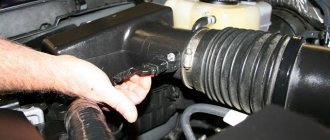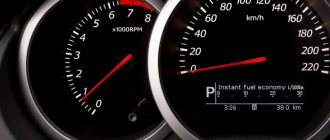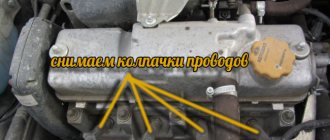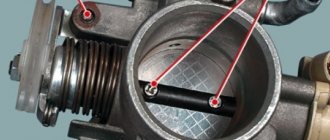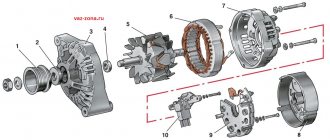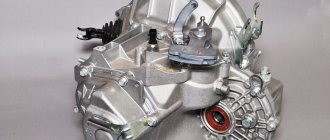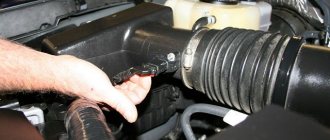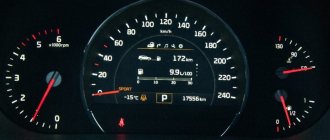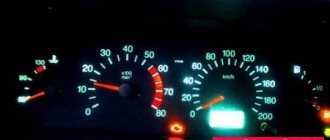In most cars, the crankshaft rotation speed after starting a cold engine is 2-3 times higher than at idle after warming up. This ensures stable operation of the internal combustion engine in this mode and reduces the time it takes to reach operating temperature. Too low speeds when the engine warms up are usually a sign of an imbalance in the air-fuel mixture.
In this article we will tell you what speed should be when starting on a cold one and for what reasons they fall below normal most often.
What engine speed should be when starting from cold?
In the first seconds after starting a cooled gasoline engine, the crankshaft speed is usually set at 1200-1500 rpm using a mechanical or electronic idle speed controller, or independently. The diesel engine warms up at a speed of about 1100 rpm .
In the case of automatic control, as it warms up, the speed decreases smoothly or abruptly until it reaches 600-800 rpm. However, exceptions are possible when this value changes according to a more complex pattern. The exact number of engine revolutions at cold start, also called warm-up, and at idle depends on the design of the power system, the settings of the electronic control unit (ECU), and the temperature of the coolant.
What should the warm-up speed be: video
In models that meet the EURO-5 and EURO-6 environmental classes, the electronic control unit often does not raise the cold speed above 1100 rpm. This is explained by the need to limit the amount of harmful emissions. In some cars, the crankshaft rotation speed immediately after starting the engine is 800-1000 rpm and only then increases. This mode is due to the desire of automakers to reduce the load on the engine at low temperatures, when it is most vulnerable.
The number of engine revolutions during a cold start and the time it takes to reduce them to idle also vary depending on the temperature. In cold weather, it takes longer to warm up the coolant, so the crankshaft speed may not drop to the required idle speed for more than 5 minutes. In summer, it stabilizes in 2-3 minutes.
Thus, engine speeds below 1200 rpm or their slight fluctuations immediately after starting are not always a sign of trouble. You should only worry when the crankshaft rotation speed when cold does not rise above 600 rpm , falls below 400 , or does not stabilize as it warms up, and the engine stalls or stalls when starting!
Checking the mass air flow sensor
So, first, to check the mass air flow sensor, turn on the ignition. You need to check the voltage with a multimeter. Measure it between the contacts with the green and yellow wires. On different cars, the voltage can vary from 0.9 to 1.2 V. You can determine if the mass air flow sensor has failed by the appearance of the spark plugs - black carbon deposits indicate that it is better to replace it.
What are warm-up speeds for and how are they regulated?
Warm-up speeds ensure stable operation of a cold engine at idle, efficient supply of more viscous oil, warming up the engine and coolant to operating temperatures. Thanks to this mode, the operating time at a pace at which engine parts are most susceptible to increased wear is reduced. In models with catalytic converters, rapid heating of their surface is additionally ensured.
Excessively low warm-up speeds and the problems that cause them can lead to more serious problems. And at a lower temperature, the engine may simply not start.
How to regulate warm-up speed on an Audi 80: video
On older carburetor models, for example, VAZ 2101-2107 before 2006, engine speed during cold start is adjusted manually. Using a special cable-operated lever known as a “choke,” the driver changes the position of the choke in the carburetor, which in turn limits the flow of air into the combustion chamber. On older cars with a diesel engine, the operating mode of the high-pressure fuel pump (HPF) is manually changed in the same way. As it warms up, the speed will increase, and the damper can be gradually closed.
In modern cars with an ECU, the crankshaft speed during warm-up is set automatically depending on the coolant temperature. In injection models, the idle speed regulator is responsible for regulating the composition of the air-fuel mixture. In the case of a diesel engine, it usually comes down to changing the operating mode of the fuel injection pump.
How to prevent air leaks?
In order to exclude or confirm the leakage of excess unaccounted air into the system, check the tightness of the air supply system.
Read also: Alarm system with auto start for Volkswagen Polo
To do this, you can remove the air pipe and blow into it from a compressor or pump. The hose can be placed in water. This will reveal cracks and other defects.
Why are the revs low when cold?
In most cases, excessively low engine speeds when cold are a sign of a lean air-fuel mixture . This may be due to excess air in it or interruptions in the fuel supply. The list of malfunctions leading to this problem directly depends on the design features of the power system. The most common causes of low speed on a cold engine with a carburetor, injector and fuel injection pump are discussed in the table below.
| Fuel supply system | Regulation principle | Malfunction | Reason for the drop in speed |
| Injector | The idle speed regulator changes the warm-up speed according to a signal from the ECU, based on the readings of the coolant temperature sensor. | The coolant temperature sensor has failed. | The ECU does not receive reliable data on the coolant temperature and, as a result, sends an incorrect signal to the IAC or goes into emergency mode. |
| The IAC is jammed. | Leaning of the mixture due to excessive opening of the IAC. | ||
| The throttle valve is not closed. | The entry of excess air due to contamination, jamming or incorrect adaptation of the throttle valve leads to a lean mixture. | ||
| Carburetor | During warm-up, the speed is adjusted by changing the position of the damper that limits the air supply. | The idle speed control is broken. | Lean mixture due to incorrect position of quantity/quality screws. |
| Low fuel level in the float chamber. | Lack of fuel due to incorrect float installation. | ||
| Excess air is sucked in through the carburetor. | Leaking seals or casings will result in a lean mixture. | ||
| EPH system malfunction. | Jamming of the solenoid valve leads to a violation of the composition of the fuel assembly. | ||
| The idle jet is clogged. | Interruptions in the fuel supply due to a decrease in the valve flow area. | ||
| Diesel | The crankshaft rotation speed to cold is set by changing the operating mode of the fuel injection pump using a speed compensator. | The thermal valve/speed compensator is faulty. | There is no adjustment of the fuel injection pump operating mode depending on the temperature. |
| The mass air flow sensor (MAF sensor) has failed. | The ECU receives incorrect data about the amount of air entering the combustion chamber, which leads to incorrect control of the operation of the injection pump in transient mode. | ||
| The EGR valve is stuck. | The composition of the air-fuel mixture is disrupted due to a failure in the supply of exhaust gases to the combustion chamber. | ||
| Fuel injection pump malfunction. | The fuel injection pump does not work correctly, which leads to disruption of mixture formation. |
A number of malfunctions can cause low speeds when cold, and in some cases even after warming up, regardless of the type of fuel and the method of formation of the air-fuel mixture. The most likely problems are:
Low speed on a cold engine, possible causes: video
- Suction of unaccounted air from the intake manifold due to mechanical damage or leakage of connections.
- Problems with fuel delivery due to a faulty fuel pump, worn or clogged injectors, or a clogged fuel filter.
- A drop in compression in the combustion chamber due to worn CPG parts, damage or incomplete closing of the valves.
- Failure in the ignition system due to incorrect adjustment, failure of spark plugs, coils, high-voltage wires and sensors.
Finding out why it does not develop speed when cold is possible only by elimination, checking sequentially all possible causes.
Why do sensors die?
Experts identify two reasons for low idle speed. One of them is related to low fuel quality. Often, a low octane number not only greatly contaminates the working surface of the sensor, but can also cause various malfunctions in the operation of electronic units.
In addition, sensors often fail due to banal defects or exceeding their service life. Inexpensive sensors may well turn out to be of low quality or defective. This is why low idle speeds appear on cars.
The role of the mass air flow sensor (MAF)
This device is designed to measure air, a certain amount of which is supplied to the manifold for mixing with gasoline. In appearance, it is a metal mesh and a measuring element placed in it with a four-pin power connector. The measuring element is equipped with a platinum string, which acts as a heat exchanger. It is cooled by the air flow coming from the air filter, and heated by supplying electricity to it; the stronger the air flow, the more electricity is supplied to the platinum.
If the DMVR fails, the electronic unit does not receive a signal about the incoming air volume, and the unit is not able to provide the required engine operating mode.
It is not difficult to check it on a warm engine; to do this, you need to disconnect the power connector from the sensor and start the engine. With this option, the electronic unit will select emergency mode and increase the number of crankshaft revolutions to 1500 per minute. After driving a car for several kilometers and realizing that the car has become much more responsive, you can identify a malfunction of the mass air flow sensor and the need to replace it.
Conclusion
A drop in engine speed is a fairly common problem. It can happen not only for any one reason - when the engine is severely worn out, an integrated approach is required, and the breakdowns can be quite specific. In this case, you may need to seek professional help.
When purchasing a car, few people think about the need for timely maintenance. Failure to do this leads to periodic breakdowns of its various mechanisms and power unit.
One of the most common malfunctions associated with improper maintenance is improper operation of a warm engine idling.
This article will help you figure out why this happens.
Spark plug
To make sure the spark plugs are working properly, you need to unscrew them all, check the gap size, as well as the presence of carbon deposits. And your car stalls while driving. The reason may be hidden in the candles. If there is heavy carbon deposits, but the gap is within acceptable values, it is necessary to clean the spark plug electrodes. But the best way out is to install new spark plugs. In the same case, if the gap is very large, there is excessive wear of the electrode, cleaning will not help, it is necessary to completely replace the set of spark plugs.
How to clean the idle air control (IAC)?
When there is a problem with low idle speed on a warm engine, in some cases it can be eliminated by flushing the IAC. To do this, de-energize the car. The regulator is located on the throttle assembly, below the TPS (throttle position sensor). You should prepare a clean rag, a screwdriver, liquid in an aerosol can - this can be any product for cleaning carburetors or injectors.
Cleaning begins with dismantling - to remove it, just unscrew the mounting screws. Sometimes there are also bolts. Once the sensor has been removed from its mounting location, the cleaning process can begin. The work is carried out using rags treated with liquid from a spray can.
It is also necessary to spray the needle from the can. The latter on various car models can be either metal or plastic. The cleaner will not damage the plastic. But the liquid should not get under the spring. If this does happen, it is recommended to blow out the sensor with compressed air as quickly as possible. If this is not done, the liquid will wash out the internal lubricant, which will cause complete failure of the IAC.
Sensor that regulates the throttle position (TPV) and its mechanism
This element, guided by a signal from the control unit, begins to open the throttle valve, which provides more gasoline and air to form the fuel mixture.
During idling, the throttle is completely closed, blocking the air flow. Any malfunction in this mechanism will cause the crankshaft speed to fluctuate sharply on a warm engine.
The breakdown of any part of this mechanism negatively affects the performance of the power unit. A malfunction in the throttle sensor manifests itself in its inability to control opening or closing, while the damper does not respond to the signal, remaining in one position. As a result, a large amount of oxygen enters the gasoline, which excessively leans the mixture, making it unsuitable for ignition in the combustion chamber of the engine. You can check the operation of the TPS with a tester. To do this, the car starts, and the black wire on the tester is connected to the car body, and the red wire is connected to the TPS contact number 1 or letter A. It should show a value from 4.8V to 5.2V. Any deviation from this norm indicates a malfunction in the power supply to the TPS.
Next, proceed to check the resistance with the throttle valve closed and open. To do this, close the remaining terminals with the multimeter wires and look at its value, which when closed is from 0.9 to 1.2 kOhm, and when open – no more than 2.7 kOhm. Any deviation means the TPS is broken and needs to be replaced.
The movement of the damper itself is also checked, which should be free. Any jamming of the damper must be eliminated by removing the resulting carbon deposits and other contaminants.
Problems in the fuel supply system
An easily established reason is the lack of fuel - a long drive with the corresponding sensor signal turned on and a zero power reserve will leave no room for doubt.
The immediate cause may also be low-quality fuel, which is poorly “ignited” by candles, or simply does not meet the octane number requirements. This is easy to understand if the gas pedal begins to “fail” when pressed. The car stalls easily if you engage the clutch. You may notice a smoky exhaust when you turn on the engine. As a rule, the problem appears some time after refueling, and becomes obvious by a drop in engine power while driving, as well as when shifting into gear. In severe cases of bad fuel, it is better to drain and flush the engine and fuel system.
Other reasons that the engine constantly stalls are interruptions in the fuel supply, which may be associated with pollution (note that diesel is more sensitive to this reason):
- fuel filter;
- injector nozzles;
- throttle valve;
- interruptions in the operation of the fuel pump.
The latter may also be “to blame” for engine stalls when braking. More often it appears when gas is released. The main symptom is a drop in engine power, and the gas pedal is “sluggish” when pressed. It does not react very dynamically to “adding gas”. By inadvertently releasing the clutch, you can stop the engine. Then, contamination can also be judged by the fact that the car stalls (or is unstable) at idle and when braking (when the fuel supply decreases). But if the performance of the fuel filter can be easily established visually and easily eliminated by replacing it, then the intervention of a specialist will be required to diagnose other causes and eliminate them.
Another reason associated with the fuel pump is gasoline boiling in it. This can happen in hot weather while driving slowly or while stuck in traffic. The car stalls while driving, at idle and if the clutch is engaged, but then it starts. In these cases, parking with the engine off to cool down can help. When you turn on the cabin heating to full, with increased engine exhaust, you can try to continue driving.
Owners of VAZ cars solve this problem in the summer in the following way: a piece of dense material moistened with water is thrown over the fuel pump. As it dries, it must be re-wetted.
